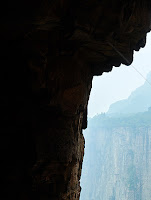What is its original meaning from the view of pictography back to 3000+ years ago?
The shell bone script for character Yin is not found, so we start the bronze script for the character,
Left is a cliff, ancient Chinese lived in caves in the bottom of cliff.
From their view, they see cliff all the time.
On the right of the script, the top is mouth (the triangle), the bottom is cloud. Ancient Chinese believed that there is a King in the sky who is in charge of weather. When he spits clouds from his mouth, it is a cloudy day.
Yin is the shade of the cliff, or the cliff under shade.
The shell bone script for character Yang is
The bottom part is the sunlight by 《象形字典》(Dictionary of Pictography).
Yang is the sunshine side of the cliff, or cliff under sunshine.
the left is the cliff, and the right are mouth (top) and cloud (bottom).
The small seal script for the character are sun (top) and sunshine (bottom)
Let us put them together
which is Yin-Yang, shade of cliff and sunshine of cliff.
Let see the famous diagram below
It is called Yin-Yang diagram or Tai Chi diagram, the best diagram for the principle of Yin-Yang.
Let's make a circle virtually from the top black spot clock-wisely
1, We start at the top point (0 degree), move along the curve clockwise, we have the most white (Yang) with a small black spot (like the head of white tadpole or the tail of the black tadpole) meet more and more black area (Yin increases), and white is getting less (Yang decreases).
From the concept of shade and sunshine, we start at 12 PM, the brightness of the day. We go afternoon, sunshine side is getting weaker, and the shade side is getting stronger.
2, We continue to move clockwise, when we get 180 degree (the bottom of the circle), we reach the point there is most black (Yin), and least white (Yang). It is the Yin extreme point.
From the concept of shade and sunshine, we get to midnight, the cliff's brightness almost all gone, it is covered by shade or darkness.
3, we continue to move clockwise, we meet less black (Yin), and more white (Yang).
From the concept of shade and sunshine, the cliff has more bright, and less darkness during 12 - 6 AM.
4, continue to move clockwise, we come back to the starting point with the most white (Yang) and least black (Yin), we reach the Yang extreme point.
From the concept of shade and sunshine, the cliff begins to have more bright, and sunshine comes back, and gets stronger.
The above is the original meaning of the Yin-Yang.
Now people may see Yin-Yang below (simplified characters)
The Yin
In addition, this kind relationship (月/日) has dramatically expended the application range of Yin-Yang. People use Yin-Yang relationship in Man/Woman, Heaven/Earth, Summer/Winter, Fire/Water, and many more, each has the same relationship as that of Moon and Sun.






















